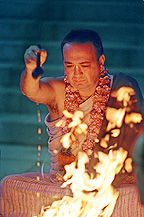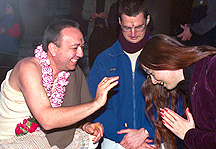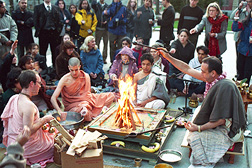



© 2000 VNN
|
WORLD May 12, 2000 VNN5939 Comment on this story His Grace Srila Turiya Das Mahasaya Performs Fire Yugna At Harvard University BY NITAI-CARAN DAS USA, May 12 (VNN) — By Nitai-caran das, President Harvard Extension School Chaitanya Vaishnava Society  "The goal of Vedic culture is to elevate the living being to consciousness of the Supreme. This includes processes of meditation and sacrifice as one offers one's mind and self to the remembrance of God. A yugn a (sacrifice) such as the agni-hotra (fire ceremony) is performed through fire and prayers. Sacred hymns are recited and sacrificial grains such as barley are offered into the fire as an act of devotion to God." With these words His Grace Srila Turiya Das Acharya Mahasaya, a Hindu priest of the Gaudiya Vaishnava tradition, began the performance of a traditional Hindu fire ceremony at Harvard University on the evening of April 13 of this year. Co-sponsored by two Hindu student groups at the university, Dharma and the Chaitanya Vaishnava Society, the fire ceremony was organized as a cultural and educational event intended to promote awareness and understanding of Vedic culture within the Harvard community.
Arriving at about 5:30 on a chilly, but calm and clear afternoon, Acharya Mahasaya and his assistants began preparations for the performance of this most ancient and elaborate of Vedic ceremonies. An auspicious location in the center of the famous Harvard Yard was secured for the event. This location, on the side of Harvard's Memorial Church, is the same spot where the commencement speaker stands while giving the graduation speech to several thousand people each year. So those in attendance who understood the sacred nature of the fire sacrifice also understood the importance of performing such an auspicious ceremony in the center of one of the world's most important universities. By reciting prayers to the Supreme Lord at such a place, the fire ceremony would purify the atmosphere of the entire university. Such is the power of the ancient Vedic fire ceremony.  By 6:30 about 50 people had gathered, including Harvard Professors of Religion Diana Eck and Edwin Bryant, and were eagerly awaiting the beginning of the ceremony. It seemed as if the blessings of the devas were there, as the notoriously unpredictable Boston weather co-operated by providing a peaceful, clear skied Thursday evening for the performance of the yugna. In keeping with the educational nature of the event, Acharya Mahasaya explained each phase of the ritual and its significance to the diverse and enthusiastic audience. "A ceremony such as this requires the sanctity of the priests both through meditation and by the sipping of sanctified water. All the objects used in the ceremony must also be sanctified with mantras, which are a type of prayer, and hymns, or by placing them over the fire after it has been consecrated. The first purifying ceremony is the sipping of water (achmana). The waters of the sacred rivers are invoked by a special prayer which is recited while touching the water: om gange ca jamune, caiva godavari sarasvasti, narmade sindho kaveri, jalesmin sannidhim kuru. The priest will also perform sacred hand gestures or mudras which symbolize aspects of the Divine such as the sacred chakra or wheel of protection. Then the priest sips the consecrated water while reciting various names of Lord Vishnu: om keshavaya namaha, om narayanaya namaha, om madhavaya namaha."  Acharaya Mahasaya, with the help of two young assistants, then recited the five verses known as shanti panchakam for the invocation of auspiciousness. Within a few moments, the ancient and primeval sound vibrations of the Vedic mantras were resounding loudly through the courtyards of the university, sanctifying the ether which is beyond the grasp of the material senses. It was amazing to think of how the very bricks of these historic buildings, within which great admirers of the Vedic brahmanas such as Ralph Waldo Emerson and Henry David Thoreau had stood, were now being purified by the sacred potencies of the Vedic hymns. It seemed quite fitting, if not long overdue, that in this great institution of higher learning the most holy and sublime spiritual knowledge should be presented by means of such a demonstration. Emerson and Thoreau, those great Western seekers of Truth, would have been pleased to see representatives of the pure spiritual path presenting this knowledge in such an important place. Following the shanti panchakam, the priests recited the swasti vachanam, or prayers for auspiciousness, while offering yellow rice, a symbol of auspiciousness. One wondered if Acharya Mahasaya, who normally resides in Hawaii, as well as the other priests and numerous spectators, would be affected by the 50 degree weather. But as soon as the Vedic hymns began to be chanted it seemed as if everyone was protected by the transcendental potency of these sacred prayers. Within a few moments, everyone was absorbed in the performance of the ceremony and the instructions of the expert priest.. Accompanied by the ringing of bells and the blowing of the sacred conch shell sounded three times, the fire was lit and the priests then chanted prayers known as purusha shukta, or prayers to the Supreme Lord. Acharya Mahasaya then explained the significance of the purusha sukta prayers, "Purush a means the Supreme Personality from Whom we have all come. The Vedanta Sutra states, ╬janmady asyataha'- ╬God is the Supreme Source from which everything has come.' In the ultimate understanding He is the Supreme Person, Govinda. The duty of the conscious beings is to worship the Supreme Conscious Being." The spectators were soon immersed in the recitation of the ancient prayers, which according to followers of the Vedas date back to the very beginning of creation. The audience was given cups of grain so they could offer a few grains into the fire each time the priests chanted, "swaha," allowing those observing to also participate in the ceremony. Edward Maldonado, a graduate student at the Harvard Divinity School, said, "It was obviously a deepening experience for many of those present, including the professors. Right here in Harvard Yard ancient Hindu practices came alive in full color. I don't think anyone expected such complexity and proficiency within a devotional framework. This was an essence that couldn't be captured simply by opening a textbook." At the climax of the ceremony, Acharya Mahasaya gave an eloquent and concise summary of Vedic philosophy, "God creates the soul, the conscious being or jiva, as a higher nature than matter. The ancient Vedic text says, n itya nityananam cetanas cetananam eko bon yo vidadati kama.'- ╬Nitya' means eternal. The Supreme Truth is eternal, and we are a part of that Supreme Truth. The Supreme Truth is conscious, and we are also a part of that Supreme Conscious Being, therefore we are eternal . . . The body will die; but we, the soul, the conscious being, will not die. The direction in which the conscious being will go will depends upon the consciousness at the time of death. Therefore, we worship the Supreme by placing our consciousness on positive remembrances of the Lord in everything we do. In this consciousness the living being can remember that everything that exists comes from the Divine . . .  We must remember that we are a part of that Supreme Divinity. So in that consciousness we also worship the Supreme Source from which we have all come, that Supreme Fire from which the sparks of consciousness have manifest. Honoring that Supreme we offer the grains into the fire representing all our actions, deeds, and words. Thus we say, ╬All our life, actions, and words are dedicated to You.' To live in harmony with the Supreme means to live in harmony with Truth, and in so doing we will live in harmony with all beings." In all, the ceremony lasted approximately one hour. After reciting the concluding prayers, the priests and spectators then circumambulated the altar of the fire ceremony three times. Everyone then received a dab of holy ashes from the fire on their foreheads. It was indeed a great blessing for all those present to attend such a ceremony and it was clear that the audience left with a feeling of both amazement and satisfaction. "I have always been intrigued by the Hindu religion," said Michael Zani, a student at the Harvard Business School, "The ceremony was an incredible display of ancient tradition and lasting faith. I found the experience memorable in it's depth and meaning." After the fire ceremony, Acharya Mahasaya, who had come all the way from Maui, Hawaii where he maintains a traditional Radha-Krishna temple and six-acre spiritual sanctuary, gave a one-hour lecture in Harvard's philosophy building entitled "India's Bhagavat Dharma: The Way of Devotion." The lecture, was a discussion of the basic philosophical principles of bhakti yoga and the significance of the Srimad Bhagavatam, which is considered the summum bonum of the Vedic literature by Gaudiya Vaishnavas. The entire event was a great success and the Harvard University Gazette ran a full-page of color photos of the fire ceremony. Nisha Patel, a member of the local Hindu community who attended the event, said "This was a wonderful example of how God can bring purification, peace, and harmony to our lives and environment regardless of time,place, or circumstance." For more information about the preaching activities of His Grace Srila Turiya Das Acharya Mahasaya and Sri Vrindavan Gardens, a traditional Hindu temple on the island of Maui, Hawaii, please visit their website at: http://www.harekrishnatemple.org Comment on this story
|